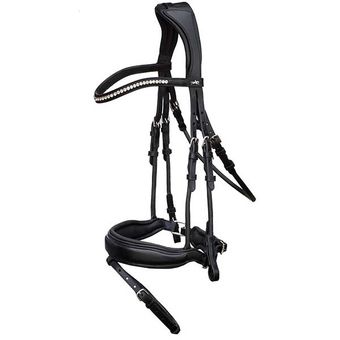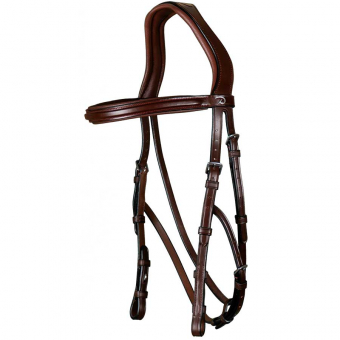The bridle creates a connection between you and the horse and can have a significant impact on the outcome of the riding session, partly depending on your influence on the reins, but also depending on the bridle's model and thus its effect. Therefore, it is important to choose the right bridle.
Which bridle is best for your horse or pony?
Bridles are designed and tailored for different disciplines and to provide different effects, so depending on whether you practice dressage, show jumping, or perhaps eventing, the best bridle for your horse may vary. Similarly, the choice of bridle can depend on your horse's age, sensitivity, and your riding level. To help you easily find the best bridle for your horse or pony, we need to start by breaking down the different types of bridles and what they are good for.
Different types of bridles and their functions
There are many different types of bridles. The most common models include:
- Remont Bridle / Bridle with a remont noseband
- English Bridle / Bridle with an English noseband
- Aachen Bridle / Bridle with an aachen noseband
- Pullar Bridle / Bridle with a pullar noseband
- Sidepull, hackamore bridles, and other bitless bridles
- Kandar and dressage bridles
- Anatomical bridles in various designs
- Different types of bridles for specific disciplines, such as western bridles, Icelandic bridles, etc.
The remont noseband, the English noseband, the aachen noseband, and the pullar noseband are essentially just nosebands that are used with a classic English bridle, creating different variations for different purposes. Most bridles have the possibility to be adjusted and customized with different parts as needed to create the optimal bridle for your horse.
Remont Bridle, or Bridle with Remont Noseband – Bridle for young horses
Remont is the military term for a young horse, so a remont bridle means a young horse bridle. The remont bridle, or bridle with a remont noseband, is especially used for young horses because the noseband, placed below the bit, is gentler on the teeth, which can be sensitive in young individuals. The remont bridle is also suitable for older horses that avoid the bit and need enhanced communication. A remont bridle provides one of the harder bits, so it should be used with caution. In addition to the mentioned uses, the remont bridle is also the most common bridle for Icelandic horses, although it is usually used without a jaw strap.
English Bridle, or Bridle with an English Noseband – Simple and versatile
The English bridle is very simple and classic. The English noseband sits inside the cheekpieces and comes in many different designs, from wide to narrow. The English bridle is highly adaptable and serves as the basis for remont bridles, aachen bridles, and pullar bridles. You can easily change the bridle's browband to make it more personal. It has many applications and is especially suitable for horses with a short nose, but it should be used with caution on young horses, as it can cause chafing in the mouth during teething.
Aachen Bridle, or Bridle with an Aachen Noseband – For horses that gape
The aachen bridle is essentially an English bridle but has an extra strap that tightens under the bit to prevent the horse from opening its mouth.
Pullar Bridle, or Bridle with a Pullar Noseband – For the spirited horse
The pullar bridle is ideal for spirited horses but can also be an alternative for young horses instead of a remont bridle. The pullar noseband consists of two straps that cross over the nose ridge, with one fastened under the bit and the other on the chin groove, providing freedom to the teeth. That's why it's a good option for young horses as well. Where the straps cross over the nose ridge, the bridle is usually extra padded, sometimes with fleece. In addition to freedom for the teeth, the pullar bridle also provides good airflow, making it particularly popular in show jumping and eventing.
Bitless bridles like sidepull and hackamore
If the horse is sensitive in the mouth or simply has difficulty accepting the bit, a bitless bridle may be a solution. It is also a good option if the horse has mouth sores or injuries that prevent it from having a bit. However, there doesn't have to be any underlying problems to choose a bitless bridle; many prefer riding bitless for other reasons. It is very common in western riding, for example. Sidepull and hackamore are variations of bitless bridles, with hackamore having shanks that you attach to a hackamore bridle. Hackamore is very sharp and has a leverage effect, while sidepull is a much milder choice.
Kandar and other bridles for dressage
A kandar is used in higher-level dressage. It is allowed in competition from Medium Level B and higher classes. The bridle usually resembles the English bridle but often has a much wider noseband, which is well-padded and anatomically shaped.
An ergonomic and anatomical bridle – more than just comfortable
Today, most bridles are anatomically designed, which is not only an ergonomic and much more comfortable option for the horse, but also makes the horse calmer and more focused on your aids, increasing communication between you. In addition to the models mentioned above, there are many new variations that have emerged with the development of anatomical bridles. One favorite is the Micklem bridle, which is a bridle from Horseware, available in the models Micklem Multibridle and Micklem Competition.
High-quality bridles become an investment for many years to come
Bridles are most often made of leather, but other variations, including nylon and synthetic leather, are also available. If you choose a high-quality leather bridle and take proper care of it, you will have a bridle for decades to come. Be sure to wash the leather and regularly apply leather conditioner to keep it soft and beautiful. You will find all the leather care you might need from us, as well as a well-assorted range of the best bridles for your horse and pony from renowned brands like Dyon and Lippo. Don't forget to complement the bridle with reins and bits for a complete set.































